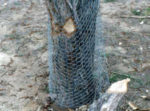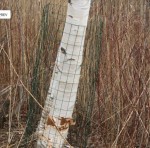Well, knock me over with a feather and color me surprised! This comes as a complete shock.

Beavers do dam good work cleaning water, research reveals
Beavers could help clean up polluted rivers and stem the loss of valuable soils from farms, new research shows.
 The study, undertaken by scientists at the University of Exeter using a captive beaver trial run by the Devon Wildlife Trust, has demonstrated the significant impact the animals have had on reducing the flow of tonnes of soil and nutrients from nearby fields into a local river system.
The study, undertaken by scientists at the University of Exeter using a captive beaver trial run by the Devon Wildlife Trust, has demonstrated the significant impact the animals have had on reducing the flow of tonnes of soil and nutrients from nearby fields into a local river system.
The research, led by hydrologist Professor Richard Brazier, found that the work of a single family of beavers had removed high levels of sediment, nitrogen and phosphorus from the water that flowed through their 2.5 hectare enclosure.
The family of beavers, which have lived in fenced site at a secret location in West Devon since 2011, have built 13 dams, slowing the flow of water and creating a series of deep ponds along the course of what was once a small stream.
Researchers measured the amount of sediment suspended, phosphorus and nitrogen in water running into the site and then compared this to water as it ran out of the site having passed through the beavers’ ponds and dams. They also measured the amount of sediment, phosphorus and nitrogen trapped by the dams in each of the ponds.
Professor Brazier said: “It is of serious concern that we observe such high rates of soil loss from agricultural land, which are well in excess of soil formation rates. However, we are heartened to discover that beaver dams can go a long way to mitigate this soil loss and also trap pollutants which lead to the degradation of our water bodies. Were beaver dams to be commonplace in the landscape we would no doubt see these effects delivering multiple benefits across whole ecosystems, as they do elsewhere around the world.”
The research findings about beavers’ positive impact on soil erosion losses and pollution in water courses come at a time of growing concern about these issues. In 2009 a separate study estimated that the total cost of soil loss from the UK’s agricultural land was £45million, much of which was due to the impacts of sediment and nutrient pollution downstream.
Ahh as if logic anything to do with it! Sure they would reduce a 45million dollar problem, but hey, they’re beavers. And as rancher Alan Newport put it so well in his 2017 article of the same name.


 Pewaukee Lake is a five mile fishing spot in Wisconsin. It is best known for it’s inland sailboat races. Not remote in any way, it is a popular summer visit for Milwakee residents, who once upon a time depended on ice harvested from its shores.
Pewaukee Lake is a five mile fishing spot in Wisconsin. It is best known for it’s inland sailboat races. Not remote in any way, it is a popular summer visit for Milwakee residents, who once upon a time depended on ice harvested from its shores.





 It happened last night around 7:30 while he and his crew were monitoring a bridge about 10 kilometres west of Merritt, where you’ve likely heard there’s been flooding.
It happened last night around 7:30 while he and his crew were monitoring a bridge about 10 kilometres west of Merritt, where you’ve likely heard there’s been flooding. Beaver supporters had an exciting festival planning meeting yesterday. I’m starting to feel that the year our event is going to be really dynamic. There will be more things for kids to do and more exhibitors and more excitement that we’ve ever had. FRo brought her sketch for the curtain panels kids will be painting, which will be wonderful and useful to us for years to come. (I’m thinking they’ll make an awesome backdrop for the stage). Kids will get to their own chalk alongside Amy on the ‘chalk walk’. And Amy’s unfolding art will dominate in the center all day long.
Beaver supporters had an exciting festival planning meeting yesterday. I’m starting to feel that the year our event is going to be really dynamic. There will be more things for kids to do and more exhibitors and more excitement that we’ve ever had. FRo brought her sketch for the curtain panels kids will be painting, which will be wonderful and useful to us for years to come. (I’m thinking they’ll make an awesome backdrop for the stage). Kids will get to their own chalk alongside Amy on the ‘chalk walk’. And Amy’s unfolding art will dominate in the center all day long.


 As a keystone species in North America, the beaver is so much more than just a hat with legs.
As a keystone species in North America, the beaver is so much more than just a hat with legs.
 As state-certified Maine Animal Damage Control Cooperators, Maynard Stanley Jr. (pictured) and his wife Norma catch and release wild animals and help solve problems and conflicts between people and animals. This beaver (pictured) was building a dam in a culvert with sticks and mud, which, if left unattended, can cause a road to wash out, sometimes just overnight. So, Rockland Public Works Department called “Critter Catcher” Maynard Stanley Jr. on Tuesday to trap the beaver. The beaver is about four years old, Stanley said, and, after trapping it, he relocated it to a Maine Wildlife Management Area far away from people.
As state-certified Maine Animal Damage Control Cooperators, Maynard Stanley Jr. (pictured) and his wife Norma catch and release wild animals and help solve problems and conflicts between people and animals. This beaver (pictured) was building a dam in a culvert with sticks and mud, which, if left unattended, can cause a road to wash out, sometimes just overnight. So, Rockland Public Works Department called “Critter Catcher” Maynard Stanley Jr. on Tuesday to trap the beaver. The beaver is about four years old, Stanley said, and, after trapping it, he relocated it to a Maine Wildlife Management Area far away from people. 



































